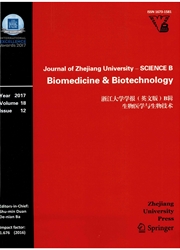

 中文摘要:
中文摘要:
在可见附近的使用红外线(NIR ) 当区别二个新西红柿的一个工具在中国(Zheza205 和 Zheza207 ) 种变化,光谱学被探索。在这研究, Zheza205 的 82 片最高华盖的叶子和 Zheza207 的 86 片最高华盖的叶子在 visible-NIR 反射模式被测量。判别式模型被开发使用的主分量分析(PCA ) ,判别式分析(DA ) ,和判别式部分最少的广场(DPLS ) 回归方法。在孤立点察觉以后,样品随机被分成二个集合,当刻度设定,使用的(n=82 ) 和留下的样品作为确认设定(n=82 ) 。当预言在确认的样品的变化设定时, DPLS 的分类正确性在优化以后当模特儿光谱预告的处理直到 93% 。有在弄平预告的处理的趋于增加的 scatter 修正和 Savitzky-Golay 过滤器以后的未加工的系列的 DPLS 模型有最好的令人满意的刻度和预言能力(刻度的相关系数(R calibration=0.196 的 c )=0.920, 根均方差,和 prediction= 的根均方差 0.216 ) 。visible-NIR 光谱学可能是一个合适的其他的工具区别西红柿的结果表演种变化所在地。
 英文摘要:
英文摘要:
The use of visible-near infrared (NIR) spectroscopy was explored as a tool to discriminate two new tomato plant varieties in China (Zheza205 and Zheza207). In this study, 82 top-canopy leaves of Zheza205 and 86 top-canopy leaves of Zheza207 were measured in visible-NIR reflectance mode. Discriminant models were developed using principal component analysis (PCA), discriminant analysis (DA), and discriminant partial least squares (DPLS) regression methods. After outliers detection, the samples were randomly split into two sets, one used as a calibration set (n=82) and the remaining samples as a validation set (n=82). When predicting the variety of the samples in validation set, the classification correctness of the DPLS model after optimizing spectral pretreatment was up to 93%. The DPLS model with raw spectra after multiplicative scatter correction and Savitzky-Golay filter smoothing pretreatments had the best satisfactory calibration and prediction abilities (correlation coefficient of calibration (Rc)=0.920, root mean square errors of calibration-0.196, and root mean square errors of prediction=0.216). The results show that visible-NIR spectroscopy might be a suitable alternative tool to discriminate tomato plant varieties on-site.
 同期刊论文项目
同期刊论文项目
 同项目期刊论文
同项目期刊论文
 期刊信息
期刊信息
